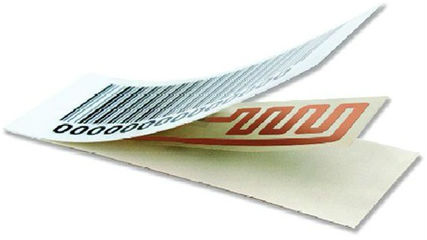A Guide for Specialty Labels
Thank you for showing interest in Specialty RFID Tags from atlasRFIDstore. An important step in evaluating your RFID tag selection is to understand the differences between specialty and standard RFID tags. This guide will provide you with a basic understanding of specialty tags, and explain the conditions in which you should consider using them.
What Makes "Specialty" RFID Tags Different?
Specialty RFID tags share many foundational components with standard RFID tags. Both begin life when an integrated circuit, or IC, (manufactured by a company such as Impinj, Alien, or NXP) is paired with a metallic antenna by a RFID inlay manufacturer (e.g. SMARTRAC, Alien, Avery Dennison, etc.).
When an IC is attached to an antenna, the product then becomes a “dry inlay”. Dry inlays are fully functioning tags and can be read by an RFID reader; however, they are not durable and they do not have an adhesive. In their original form, dry inlays are not very useful unless they go through an additional “construction” process where a dry inlay is converted into a tag with (1) adhesive, (2) backing, and (3) a “face” onto which information may be printed.
This is the fork in the road where the difference between standard tags and specialty tags begins. Standard RFID tags are designed for office-like environments while specialty tags are designed to withstand environments where Abrasion, UV Exposure, Extreme Temperatures, or Chemicals might be present.
Standard RFID Tags: Construction and Environment
Tag manufacturers design standard RFID tags to be low cost and mass produced; thus, they are not designed for atypical, niche RFID tag use cases. Examples of some common standard tags include the SMARTRAC ShortDipole and DogBone, the Alien Squiggle and G, and the Avery Dennison AD-226. These tags are made by adding a protective “face” to a dry inlay and applying a permanent adhesive to the back of the tag. While they may be cost effective, they are not engineered for exotic RFID use cases .

In a sentence, standard RFID tags are best used in an office-type environment where abrasion is unlikely, UV rays are kept out, temperatures are constant, and chemicals are absent . It is also important to note that any printing on a standard RFID tag will be deposited onto the tag’s face and, as a result, the printed information could eventually wear away.
Specialty RFID Tags: Construction and Environment
Whereas a standard RFID tag is best suited for an office-like environment, specialty tags can be designed for use just about everywhere else and withstand elements such as Abrasion, UV Exposure, Extreme Temperatures, or Chemicals. Such versatility is achieved by altering the construction of the tag.

During the conversion process, the dry inlay can be combined with more durable materials as needed in order to withstand different types of environments. In addition, sub-surface printing means that any human-readable and/or barcode print is actually below a transparent protective surface which, in turn, means that key data can be protected from wear.
When Should You Consider Using Specialty RFID Tags?
Consider testing with specialty RFID tags if your application includes extremes of any type. Below are some examples:
Form Factor Requirements – RFID applications sometimes require customized form factors. Specialty RFID tags can accommodate unique attachment methods (e.g. hang tags), Security features (e.g. destructibility), or size/shape.
Application Surface – While standard RFID tags may work well on surfaces like cardboard or plastic, they tend to not work well in high-liquid environments or metal surfaces. Specialty tags can be designed for on-metal or high liquid environments by carefully selecting a tag with the appropriate backing and adhesive. Furthermore, specialty tags can be designed for the desired application surface’s surface energy. Military applications, for example, require that the tag to adhere to CARC paint which is designed to repel substances. Specialty tags can use custom adhesives to adhere to a variety of surfaces.
Presence of Chemicals – Standard RFID tags do not mix well with liquids, much less chemicals. Specialized RFID tags can be designed to work in the presence of chemicals like glass cleaner, bathroom cleaner, isopropyl alcohol, acetone, NaOH, HCL, brake fluid, and many others.
Extreme Temperatures – Standard RFID tags typically are designed to work at room temperature, with some high/low fluctuations. Extreme temperatures might range from -4 to 175 degrees Fahrenheit for a standard RFID tag. Specialty tags are recommended if RFID reads are expected outside of that range. NOTE: APPLICATION temperatures (the temperatures at which a tag can initially be applied) are typically narrower temperature ranges than SERVICE temperature ranges.
Abrasion – Standard RFID tags require printing on top of the tag’s face. Thus, any printing on the tag will be subjected to abrasion and potential wear. Specialty RFID tags take advantage of sub-surface printing wherein the printed media has a protective covering. Generally speaking, specialty tags are more resistant to abrasion than standard RFID tags because they incorporate additional backing or face material.
UV Exposure – Standard RFID tags are not designed to be subjected to prolonged UV radiation (i.e. time in the sun). Specialty RFID tags can be designed for extended outdoor use and UV exposure so that the tag will be RFID readable for longer and its printed copy will be resistant to fading.
Printing Requirements – Where standard RFID tags are frequently printed only on one side in black and white, an added advantage to utilizing specialty RFID tags is that they leverage high-quality 4-color printing and/or double-sided printing. Furthermore, anything that is printed on a specialty tag is protected by sub-surface printing. In order to remove the printed information from a specialty tag, the tag itself would need to be destroyed.
The RFID tag selection process can be a complicated one. Please contact us if you have any questions about the right RFID tag for your application.
